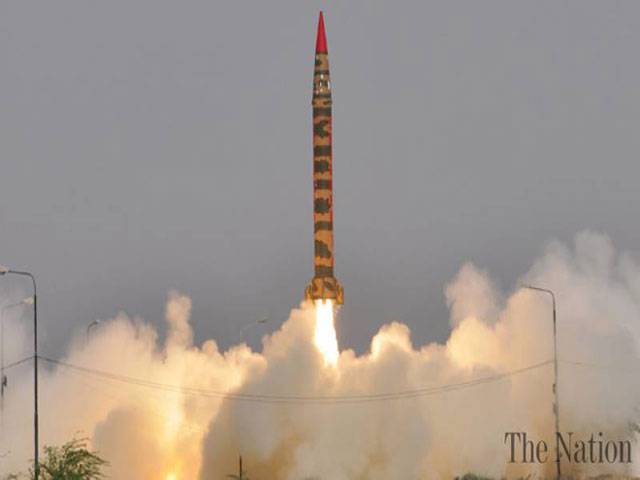Nasir Hafeez
Indian Navy has released last year its Maritime Security Strategy aimed at ensuring secure seas. This policy has quite boldly demanded Indian sea based leg of the nuclear triad as essential to maintain nuclear deterrence. The case has been built by connecting the credibility of nuclear deterrence with the survivability of nuclear forces highlighting that the sea-based segment of the nuclear triad, due to its stealth characteristics is highly survivable and can contribute to assured second strike capability.
It is interesting that in the same report, it has also been recognised that deployment of SSBN (Ship Submersible Ballistic Nuclear (submarine)) is predicated on the maintenance of robust command and control systems. Most of the readers may not know that submarines have a very complex command and control system. The communication with the submerged submarine, when it is out on long range patrols or deployed in specially selected hideouts, is very challenging. Any transmission from the submarine, if detected, can compromise its stealth operations leading to engagement and then destruction. Highly sophisticated systems based on Very Low Frequency (VLF) or Extremely Low Frequency (ELF), employing different techniques, are used to communicate. Additionally, acoustic transmission based on loudspeakers and hydrophones may also be employed to transmit messages through sonic communication equipment connected to land by underwater communication cables laid in areas frequently travelled by these submarines. The point I want to emphasise is that employing a submarine for assured second strike is a good option but communicating with this platform is highly problematic even under normal conditions. You can well imagine what may happen under hostile conditions when the adversary may also employ electronic warfare techniques to further jam the already fragile communication.
The command and control of a nuclear submarine is even more problematic. The submarine based deterrence has to rely on pre-delegation of authority. The commander of submarine once in deployed position cannot be issued the codes necessary to arm the nuclear weapon systems through any sure means. The only best option is that these codes are kept inside the submarines, under different safeguards to ensure its authorised use. In all probabilities these safeguards will work and the nuclear weapons based on submarines are used when desired and not used when not desired, ensuring both positive and negative control simultaneously.
It is important to note that the role of political leadership in the overall nuclear decision making is highly diluted when the command is pre-delegated, which is the only option in case of deployment of SSBN. Indian political leadership, which often guards jealously its authority over military, may now be ready for this pre-delegation in the highest national security decision making. There are other risks too. In case of pre-delegation the entire burden of responsibility transfers to few men, the crew of a submarine, deep inside in the depth of an ocean, in the most uncertain and highly challenging physically and psychologically environment. Asking them to make the critical decision of use of nuclear weapon without any reliable mode of communication is a risky affair and a very tough ordeal.
“INS ARIHANT”, India’s ambitious nuclear submarine programme under construction in Visakhapatnam, is partly based on the old Akula-class Soviet SSN design and is India’s first indigenously designed nuclear submarine. Its acoustic signature is very high which makes it relatively easy for potential adversaries to track. In such case the desired characteristics of stealth operations, being essential, may be compromised. Additionally, “INS ARIHANT has missed many deadlines for its deployment and has been found prone to accidents. Indian Navy, however, despite so many challenges is not in any mood to give up this ambitious project.
It is quite understandable that developing efficient and effective military hardware is a very tall order for a developing country like India which has a very poor record in this field. Therefore the recent developments can be appreciated at best as a technology demonstrator but will take a while to achieve its claimed capability.
While India is trying to build its naval leg of the triad, one thing is quite sure that this is a serious attempt to nuclearise Indian Ocean and a very dangerous one. Imagine an unreliable submarine with nuclear weapons onboard patrolling in Indian Ocean, which is the hub of sea based international communication and trade. This situation is highly risky not only for countries of the region but for the entire world and may have serious implications for the business activity emanating or passing through Indian Ocean. Any accident may create ugly situation that will be beyond the Indian capacity to handle. It is quite possible that Indian Navy may not even disclose such an accident and may try to cover up due to reasons of secrecy or national security. A similar situation occurred in the past, when Russian submarine, Kursk, met an accident in the Barents Sea in August 2000. Russian Navy did not disclose the accident for various reasons but later, due to enormous size of rescue work involved, were forced to do so and sought international help. Fortunately it was in a far off, less frequented area and there was no nuclear explosion. In case of India, similar reaction is expected which can be dangerous and highly serious for the maritime security of Indian Ocean.
To sum up, it is highly disturbing for Pakistan that India is developing its second strike capability which may upset the strategic stability in the region. It may dilute political control of Indian Nuclear weapons. At the same time it is highly risky and may have serious implications for maritime security of the entire Indian Ocean. While India is striving hard to tilt the power balance in its favour, Pakistan also has to do something to restore strategic balance in the overall interest of peace in the region and in the world.
Email: nh_pk@hotmail.com
The writer is PhD scholar at NDU and currently associated with Strategic Vision Institute Islamabad Pakistan.






